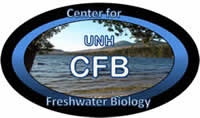Abstract
A field study was conducted during the summer, 2005 to evaluate the lake water quality and planktonic communities in Pawtuckaway Lake, NH. Of special concern was the condition of the plankton populations since the lake had been subjected to introductions of adult sea-run alewife
Overall water quality ranged from mesotrophic to eutrophic based on total phosphorus (8-31 !g L-1), chlorophyll a (max South, 5.0 !g L-1) and Secchi disk transparency (max North 5.1 m, min South 2.8 m). Of the three sites sampled, Fundy, North and South, Fundy (Zmax < 2 m) did not stratify and had the highest concentrations of total phosphorus, followed by North and South sites, respectively. North and South sites stratified throughout the summer and developed anoxic hypolimnia, with the most severe oxygen deficit at the North site
Potentially toxigenic cyanobacteria were detected at all three sites. Throughout the summer, the concentrations of the cyanotoxin microcystin in the lake were well above the average for NH lakes. Lakewater concentrations of microcystins exceeded WHO drinking water standards (1000 ng L-1) at the North site (1204.0 ng L-1) on July 21. The two dominant cyanobacteria were Anabaena spp.. and Microcystis aeruginosa. Oscillatoria (Planktothrix) were also present, but only rarely and therefore were probably were not responsible for most of the microcystins present in the lakewater.
Publication Date
1-1-2006
Publisher
UNH Center for Freshwater Biology Research
Document Type
Article
Recommended Citation
Trout-Haney, Jessica V., "An assessment of plankton populations, toxic cyanobacteria, and potential
impact of introduced marine alewife (Alosa pseudoharengus) in Pawtuckaway
Lake, New Hampshire" (2006). Center for Freshwater Biology. 8.
https://scholars.unh.edu/cfb/8

